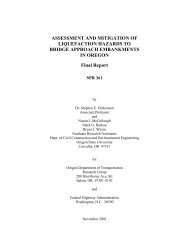Oregon Balance of State HIV/AIDS Housing & Services Systems ...
Oregon Balance of State HIV/AIDS Housing & Services Systems ...
Oregon Balance of State HIV/AIDS Housing & Services Systems ...
Create successful ePaper yourself
Turn your PDF publications into a flip-book with our unique Google optimized e-Paper software.
42 <strong>Oregon</strong> <strong>HIV</strong>/<strong>AIDS</strong> <strong>Housing</strong> and <strong>Services</strong> <strong>Systems</strong> Integration Plan<br />
case managers updated on planning processes (including opportunities for community input on<br />
Continuum <strong>of</strong> Care, Consolidated Plan, and other processes and applications) or inform them <strong>of</strong><br />
resource availability or collaborative opportunities. This limits the opportunities that <strong>HIV</strong>/<strong>AIDS</strong><br />
housing and services stakeholders have to help shape inclusive plans, and thus limits the degree to<br />
which people living with <strong>HIV</strong>/<strong>AIDS</strong> are included in mainstream housing and other services.<br />
Detailed information about the OHOP and <strong>HIV</strong> Care and Treatment programs is or will be available<br />
in the form <strong>of</strong> reports and publications such as this Plan, but not all potential partners are likely to<br />
seek out or read lengthy documents on these topics.<br />
2. Confidentiality Concerns<br />
The need to maintain client confidentiality restricts the ways that OHOP housing coordinators and<br />
other organizations and individuals can conduct outreach about their activities and resources. For<br />
people living with <strong>HIV</strong>/<strong>AIDS</strong>, stigma and discrimination are significant factors in finding and<br />
maintaining housing, accessing support services, and seeking medical care. People living with<br />
<strong>HIV</strong>/<strong>AIDS</strong> <strong>of</strong>ten struggle with keeping their <strong>HIV</strong> status private, particularly from landlords and<br />
neighbors. For this reason, OHOP staff and partners market their services quietly to avoid<br />
disclosing to landlords and other providers that HOPWA is the source <strong>of</strong> housing assistance for<br />
clients they place, or that clients qualify for OHOP via an <strong>HIV</strong> diagnosis. The need to maintain<br />
privacy around <strong>HIV</strong>/<strong>AIDS</strong>-related services and programs such as OHOP can limit opportunities for<br />
collaboration, outreach, and landlord education.<br />
Moreover, CAAs and other community-based providers that would like to be able to make referrals<br />
to the OHOP program do not necessarily know which <strong>of</strong> their clients are living with <strong>HIV</strong>/<strong>AIDS</strong>, or<br />
how to ask for or provide information in a way that allows those individuals to maintain privacy.<br />
3. Limited Staff Capacity<br />
OHOP and <strong>HIV</strong> Care and Treatment staff have limited resources and time to conduct marketing and<br />
outreach to mainstream housing and service providers, in addition to serving individual clients or<br />
coordinating specific housing activities. In addition, these staff may lack familiarity with aspects <strong>of</strong><br />
partner systems, including affordable housing, and have limited training to expand this knowledge.<br />
Integration with <strong>Housing</strong> and Service <strong>Systems</strong><br />
Affordable <strong>Housing</strong> Resources<br />
Coordination and partnerships with affordable housing developers and providers (including housing<br />
authorities) and affordable housing planning processes (such as the Consolidated Plan or Low<br />
Income <strong>Housing</strong> Tax Credit processes) can lead to the development or dedication <strong>of</strong> new housing<br />
resources, targeted either for people with disabilities in general or specifically for people living with<br />
<strong>HIV</strong>/<strong>AIDS</strong>. Good communication can also lead affordable housing providers to prioritize existing<br />
resources for people living with <strong>HIV</strong>/<strong>AIDS</strong>, whether because <strong>of</strong> an increased perception <strong>of</strong> this<br />
population’s housing need or recognition <strong>of</strong> the resources that can be leveraged to serve them.<br />
4. Prioritizing Participation Among Many Planning and Implementation Processes<br />
Mechanisms for community input are frequently built in to affordable housing planning processes,<br />
but it can be difficult for OHOP staff and partners to track the time-limited opportunities to provide

















